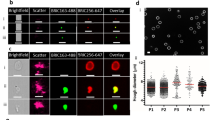Abstract
IN an attempt to provide a chemical basis for an understanding of the morphological appearance of human red cells and of the changes in red-cell morphology in various hæmatological disorders, we have fractionated red-cell stroma preparations by electrophoresis. Three lipid-containing protein fractions have been separated, two of which migrate readily in veronal buffer at pH 8.6 (µ = 0.1). Red-cell stroma was prepared initially in the manner described by us1, but in addition was washed twice with 0.1 M potassium dihydrogen phosphate and three times with distilled water. A stromal extract obtained with 0.2 M ammonium hydroxide and containing 18 µgm. of tyrosine equivalents of protein2 was then subjected to paper electrophoresis3.
This is a preview of subscription content, access via your institution
Access options
Subscribe to this journal
Receive 51 print issues and online access
$199.00 per year
only $3.90 per issue
Buy this article
- Purchase on Springer Link
- Instant access to full article PDF
Prices may be subject to local taxes which are calculated during checkout
Similar content being viewed by others
References
Prankerd, T. A. J., and Altman, K. I., Biochem. J. (in the press).
Lowry, O. H., Rosebrough, N. J., Farr, A. L., and Randall, R. J., J. Biol. Chem., 193, 265 (1951).
Plückthun, H., and Götting, H., Klin. Wschr., 29, 415 (1951).
Author information
Authors and Affiliations
Rights and permissions
About this article
Cite this article
PRANKERD, T., ALTMAN, K. & ANDERSON, J. Electrophoresis of Human Red-Cell Stroma. Nature 174, 1146–1147 (1954). https://doi.org/10.1038/1741146a0
Issue Date:
DOI: https://doi.org/10.1038/1741146a0
This article is cited by
-
Water-soluble proteins of the human red cell membrane
The Journal of Membrane Biology (1970)
Comments
By submitting a comment you agree to abide by our Terms and Community Guidelines. If you find something abusive or that does not comply with our terms or guidelines please flag it as inappropriate.



